North Carolina is a beautiful state, which is home to several lakes and rivers. As such, it is abundant in aquatic wildlife, which includes water snakes. Interestingly, the state is home to a diverse set of water snake species, and you’ll get to know all about them in this article.
What are the water snakes in North Carolina? The 12 water snakes in North Carolina are:
- Copperhead
- Rainbow Snake
- Mud Snake
- Ribbon Snake
- Garter Snake
- Black Swamp Snake
- Queen Snake
- Glossy Crayfish Snake
- Red-Bellied Water Snake
- Brown Water Snake
- Banded Water Snake
- Midland Water Snake
If you want to learn more about each of these water snakes, you came to the right place. Here, you’ll be able to identify each of them and learn which ones are venomous and which ones are not. This article will also answer some of your frequently asked questions about the snakes in North Carolina – so read on to satisfy your curiosity.
Table of Contents
Are There A Lot of Snakes in North Carolina?
There are a lot of snakes in North Carolina. North Carolina consists of three regions, namely the Coastal Plain, the Mountains, and Piedmont. As such, it is abundant in mountains, as well as in bodies of water – the natural habitat of various wildlife.
With that said, it comes as no surprise that the state is home to around 37 snake species. Fortunately, only seven of these species are considered venomous.
Are Snakes a Problem in NC?
Snakes are not a problem in North Carolina. As earlier established, there are 37 species of snakes in North Carolina, which includes both venomous and non-venomous species. Fortunately, a majority of these snakes are considered harmless. Thus, as long as they do not feel threatened or aggravated, these snakes are not likely to attack.
12 Water Snakes in North Carolina
Copperhead
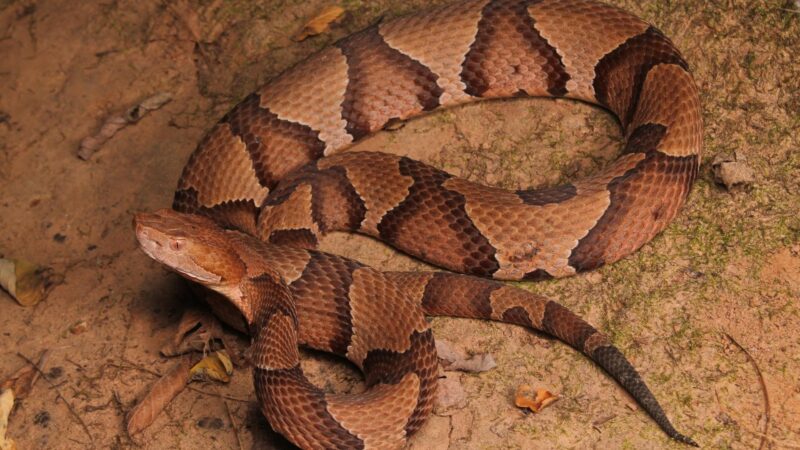
Of all the snake species in North Carolina, there’s no denying that the copperhead is the most common. It has been reported that this venomous snake is responsible for a majority of snake bites in the state.
However, it must be noted that copperheads are not aggressive by nature. They only tend to bite and attack when they feel threatened. So if you ever come across a copperhead, it’s best to leave it alone – so it would just crawl or swim away.
- Scientific Name: Agkistrodon contortrix
- Appearance: The copperhead snake derives its name from its solid copper-colored head. The rest of its body is either reddish-brown or light brown with dark brown-colored hourglass patterns across its length. It is a large breed with a thick muscular body with an arrow-shaped head.
- Color: Reddish-brown, light brown
- Lifespan: 18 years
- Length: 24 to 36 inches
- Diet: Mice, birds, amphibians, insects, and even small snakes
- Place of Origin: Eastern North America
- Venomous: Yes
Rainbow Snake
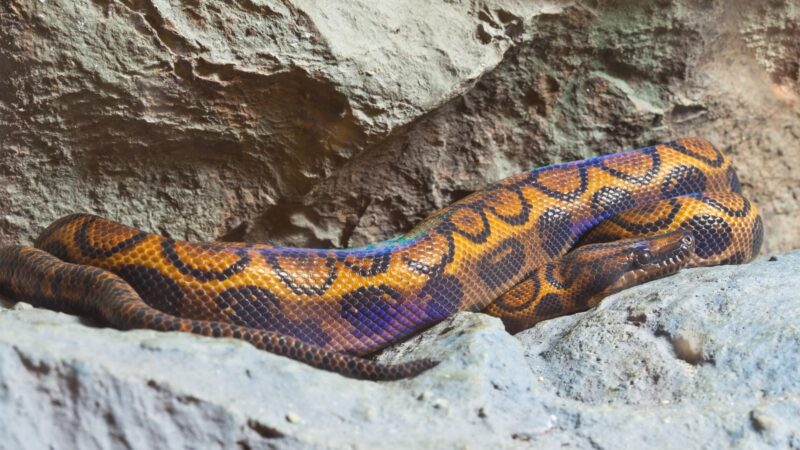
One of the most beautiful snake species in North Carolina is the rainbow snake. Sightings of this non-venomous snake are quite rare since it’s mostly active at night. Otherwise known as the eel moccasin, the rainbow snake is a carnivorous species that largely feeds on eels.
- Scientific Name: Farancia erytrogramma
- Appearance: Rainbow snakes are predominantly covered in lovely iridescent dark blue scales. Along the sides of its body, there are light-colored scales with colors ranging from orange, yellow, or red scales. It has a slender body with a small head.
- Color: Bluish-black base color with multi-colored scale patterns
- Lifespan: 19 years
- Length: 27 to 48 inches
- Diet: Eels
- Place of Origin: Northern Australia
- Venomous: No
Mud Snake
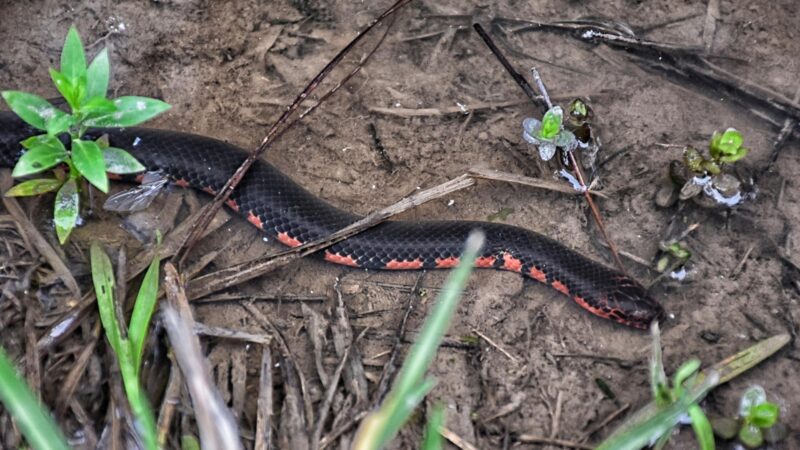
Another water snake that can be found in North Carolina is the mud snake. As its name implies, its primary habitat includes muddy areas, particularly those near ponds, marshes, and swamps.
Because it prefers to hide in muddy areas, sightings of this non-venomous snake are quite rare. Even if you come across its home by accident, mud snakes rarely attack due to their non-aggressive nature. However, it does have a pointed tail which it uses for self-defense.
- Scientific Name: Farancia abacura
- Appearance: Mud snakes are a large snake breed that’s notable for their glossy scales. It is predominantly covered in black scales, while its sides have red to orange-red colored spots all over. It can be distinguished by the pointed tip at the end of its tail.
- Color: Glossy black and red
- Lifespan: 19 years
- Length: 40 to 54 inches
- Diet: Salamanders and amphibians
- Place of Origin: Southeastern United States
- Venomous: No
Ribbon Snake
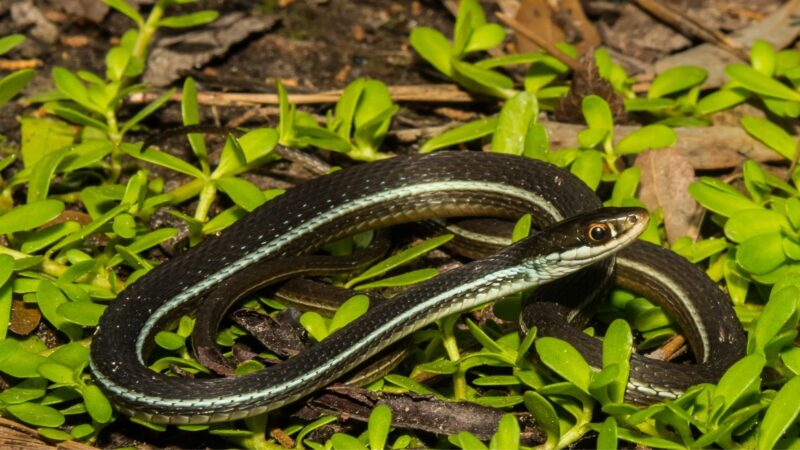
The ribbon snake is another beautiful water snake found in North Carolina. It is another non-venomous snake species that are known for being shy. As such, they often flee when they sense danger nearby. Thanks to their slender bodies, ribbon snakes are quite agile, especially when they’re swimming underwater.
- Scientific Name: Thamnophis sauritus
- Appearance: Ribbon snakes are easy to distinguish because of their predominantly dark-colored bodies with yellow stripes. Their base scales are usually black or dark brown, while they have three yellow stripes along the sides of their bodies. They have long slender bodies that help them move quickly.
- Color: Dark brown and yellow, black and yellow
- Lifespan: 10 to 11 years
- Length: 18 to 26 inches
- Diet: Fish, newts, salamanders, frogs, earthworms, spiders, and caterpillars
- Place of Origin: Eastern North America
- Venomous: No
Garter Snake
Another non-venomous water snake that can be found in North Carolina is the garter snake. But don’t let its seemingly harmless exterior fool you – a garter snake can be quite aggressive when provoked.
While garter snakes have small mouths with minimal bite force, their bites can be itchy and uncomfortable. Some even develop allergic reactions from its bite. Thus, it’s best to leave a garter snake alone if you see one.
- Scientific Name: Thamnophis
- Appearance: Garter snakes are medium-sized snake species with long and slender bodies. Its body is predominantly covered in black scales with yellow stripes running along its length. Some garter snake species have red spots along the sides of their bodies. Garter snakes give off a friendly appearance thanks to their big round eyes.
- Color: Black, greenish-brown, tan, or gray
- Lifespan: 10 years
- Length: 18 and 26 inches
- Diet: Earthworms, amphibians, leeches, slugs, snails, insects, crayfish, fish, and other small snakes
- Place of Origin: North and Central America
- Venomous: No
Black Swamp Snake
The black swamp snake is another water snake you can find in North Carolina. This snake species is highly aquatic and can often be found submerged under vegetation or in wetlands. These snakes usually swim away when they feel threatened and are considered harmless.
Black swamp snakes are quite small, so they are often observed to travel in groups to help protect each other. So if you happen to spot one, there’s a chance there are others nearby.
- Scientific Name: Seminatrix pygaea
- Appearance: The black swamp snake is a small snake breed characterized by its glossy black scales. They have bright orange or orange-red bellies, which highly contrast their dark-colored back. They have small heads with thick bodies.
- Color: Glossy black and red
- Lifespan: 7 years
- Length: 10 to 15 inches
- Diet: Fish, tadpoles, frogs, salamanders, sirens, amphiumas, and invertebrates
- Place of Origin: Eastern North Carolina to Southern Alabama
- Venomous: No
Queen Snake
The queen snake is a semi-aquatic snake that’s common across the North American continent. They are known for being harmless, but they do excrete a pungent smell when they feel attacked.
Interestingly, their name is derived from their scientific name – Regina septemvittata. In Latin, “Regina” means “queen.”
- Scientific Name: Regina septemvittata
- Appearance: The queen snake is a medium-sized snake species with a long and slender body. It has predominantly dark-colored scales ranging from olive green to dark brown. They can be distinguished from other snake species thanks to the yellow stripes on their lower sides. Compared to other water snakes, they have smaller eyes, giving them a less bug-eyed appearance.
- Color: Olive green, gray, or dark brown
- Lifespan: 19 years
- Length: 15 to 24 inches
- Diet: Crayfish
- Place of Origin: Mississippi
- Venomous: No
Glossy Crayfish Snake
The glossy crayfish snake is a non-venomous semi-aquatic snake commonly found in North Carolina as well as the Southeastern side of the United States.
As its name implies, it’s a big predator of crayfish. In fact, its teeth are shaped like chisels to help bite through tough crayfish scales.
- Scientific Name: Regina rigida
- Appearance: The glossy crayfish snake shares a resemblance to the queen snake, with its dark brown to olive green scales. Some subspecies also share the same yellow stripes along the sides of its body. To distinguish the glossy crayfish snake from the queen snake, the former has glossier scales – as its name suggests.
- Color: Glossy brown to olive
- Lifespan: 15 to 30 years
- Length: 14 to 24 inches
- Diet: Crayfish
- Place of Origin: Southeastern United States
- Venomous: No
Red-Bellied Water Snake
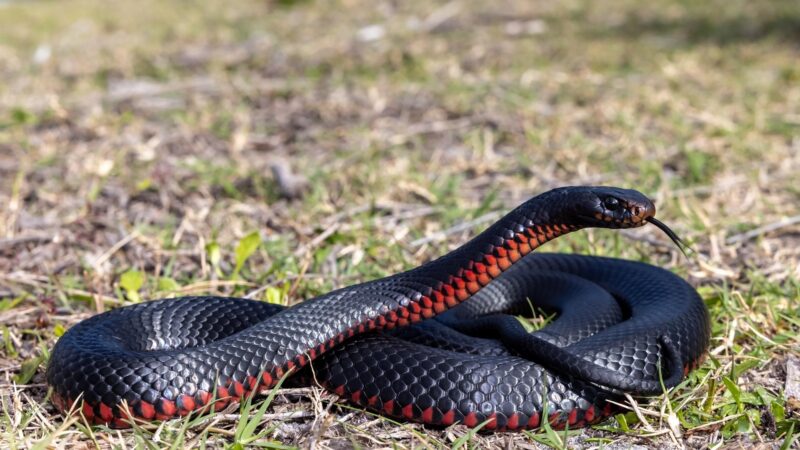
The red-bellied water snake is a beautiful water snake that can easily catch your attention. But as tempting as it is to admire its beauty, it’s best to keep a distance since this snake is known for being quite aggressive. Fortunately, it is not venomous, although its bite can be very painful.
- Scientific Name: Nerodia erythrogaster
- Appearance: True to its name, the red-bellied water snake is easily distinguished because of its bright orange-red scales beginning from its lower mouth and extending to the rest of its belly. The rest of its body is covered in dark brown or reddish-brown keeled scales. It has an arrow-shaped head, beady eyes, a narrow neck, and a thick body.
- Color: Reddish-orange and bright to dark brown
- Lifespan: 4 years
- Length: 30 to 48 inches
- Diet: Amphibians and fishes
- Place of Origin: Australia
- Venomous: No
Brown Water Snake
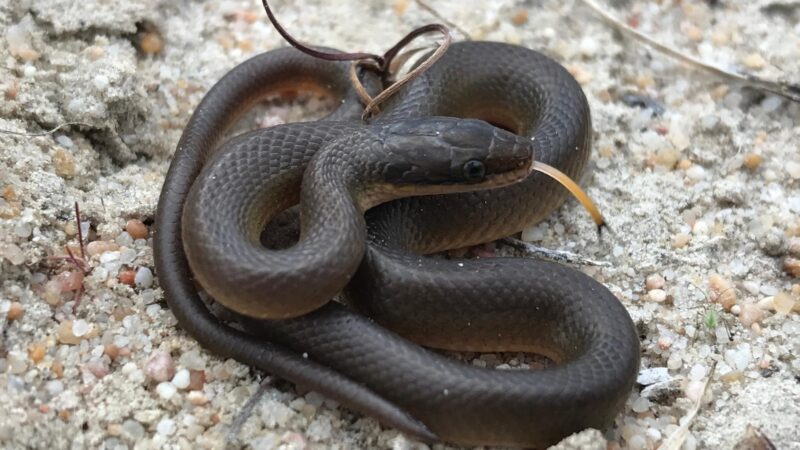
The brown water snake is one of the most common water snakes. Not just in North Carolina but throughout the Southeastern United States. Interestingly, brown water snakes are excellent climbers despite being water snakes.
While this snake species is non-venomous, it is very aggressive. And given its large size, its bite can be forceful – and equally painful. Nevertheless, it is not known to attack without reason, so make sure to just leave it alone in case you spot one.
- Scientific Name: Nerodia taxispilota
- Appearance: Brown water snakes are large-sized snake species with thick bodies, narrow necks, and arrow-shaped heads. Based on its name, its body is covered in brown scales with dark brown patches along the side of its body.
- Color: Brown to Light tan
- Lifespan: 9 years
- Length: 30 to 60 inches
- Diet: Catfish, crayfish, lizards, and frogs
- Place of Origin: Southeastern United States
- Venomous: No
Banded Water Snake
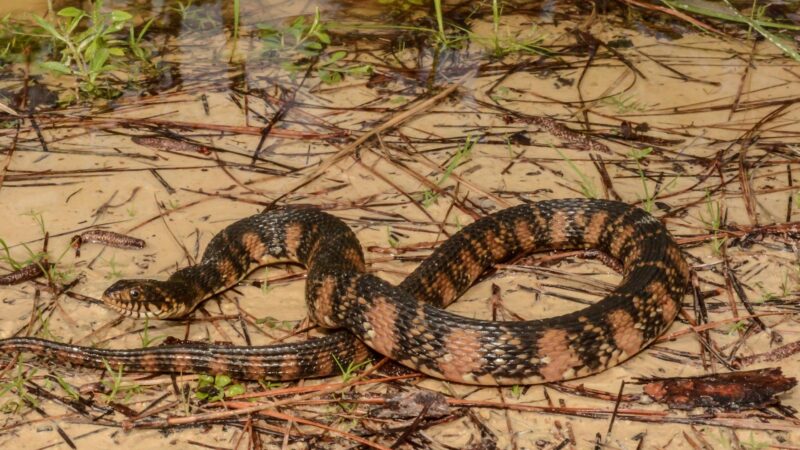
The banded water snake is another non-venomous water snake species endemic to North Carolina. This solitary creature is quite active throughout the day and night, often hunting in shallow waters.
Because of its color, it may be hard to spot while it’s underwater. In case you accidentally step on it, it usually releases a foul odor and swims away. But in case it feels threatened, it will not hesitate to bite – and its bites are infamous for being painful. Fortunately, the banded water snake is non-venomous, so you don’t have to worry about the lethal effects of its bite.
- Scientific Name: Nerodia fasciata
- Appearance: The banded water snake is a medium-sized snake breed with predominantly tan, dark brown, or gray-colored scales. It has a pattern of dark brown or black bands across its body, hence its name.
- Color: Grayish-brown
- Lifespan: 8 years
- Length: 24 to 48 inches
- Diet: Fish, frogs, tadpoles, and salamanders
- Place of Origin: North Carolina to Southwest Alabama
- Venomous: No
Midland Water Snake
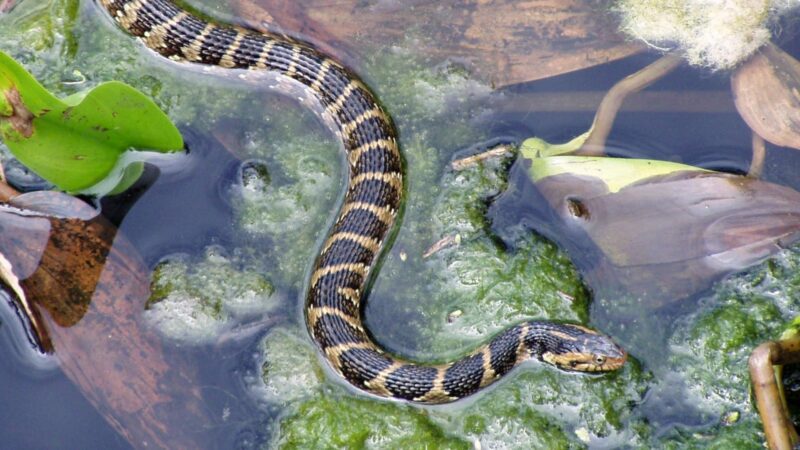
Completing this list of the 12 water snakes in North Carolina is the midland water snake. This snake species is among the most docile, often considered harmless to people and pets. They are also non-venomous, so an accidental bite will not be lethal – but still painful. Even then, it has been observed that the midland water snake only bites when it is intentionally attacked or threatened.
- Scientific Name: Nerodia sipedon pleuralis
- Appearance: The midland water snake is a medium-sized snake with a bulky body and a small head. It has a beautiful pattern of square-shaped blotches of dark brown scales in alternating positions running throughout the length of its body. Its base color is light brown or reddish-brown, which highly contrasts the alternating pattern on its body.
- Color: Light brown with dark brown or reddish-brown crossbands
- Lifespan: 9 years
- Length: 24 to 30 inches
- Diet: Amphibians and fishes
- Place of Origin: North America
- Venomous: No
How Many Snake Bites a Year in North Carolina?
On average, there are around 350 reported snake bites in North Carolina every year. It has been reported that during active months like May, the number of monthly snake bites can rise to around 90.
What Is the Most Poisonous Snake in North Carolina?
In terms of the lethality of its venom, the Eastern diamondback rattlesnake is considered to be the most poisonous snake in North Carolina. The Eastern diamondback rattlesnake venom is quite lethal since it’s known to cause blood and tissue damage. While they is considered highly venomous, it’s quite a rare snake to come across.
What Is the Most Common Snake Bite in North Carolina?
The most common snake to come across in North Carolina is the copperhead. Fortunately, while the copperhead is a venomous breed, its venom is not as lethal as that of the Eastern diamondback rattlesnake.
North Carolina is home to 37 snake species, 12 of which are water snakes. But even considering this large number, only seven species are venomous. So if you ever come across a snake while visiting this beautiful state, the chances of it being venomous are quite small. As long as you’re not showing any aggressive behavior, the snake will most likely just slither away.
List of Sources
Bartel, J. (2021). North Carolina Snakes: Everything You Need To Know. NC State University Veterinary Medicine News.
Wilson, J. D. Mud Snake (Farancia abacura). Savannah River Ecology Laboratory.
Black Swampsnake. (2021). Florida Museum of Natural History.
Rogers, E. Red-bellied Watersnake (Nerodia erythrogaster). Savannah River Ecology Laboratory.
Midland Watersnake. Florida Museum of Natural History.